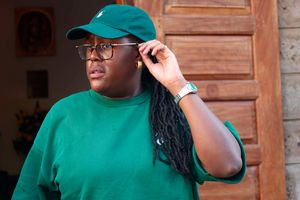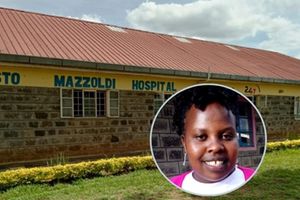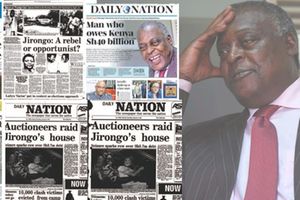Uhuru leads Kenyans in paying last respects to Kibaki
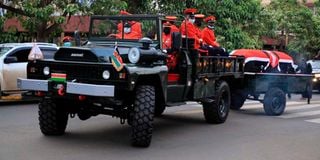
Military officers escort a gun carriage carrying the remains of former President Mwai Kibaki, who died at the age of 90, for public viewing at Parliament Buildings in Nairobi yesterday.
What you need to know:
- Next to the late President’s body are a number of items that he was closely associated with, including books, a notebook, a pen and a golf club.
- The body of Kenya’s third President will lie in state at Parliament buildings for three days, before burial on April 30 at his Othaya home in Nyeri County.
President Kenyatta seemed to be in an unusual haste yesterday when he arrived at Parliament buildings to pay his last respects to his predecessor Mwai Kibaki.
From arrival to the time he left, he took less than 20 minutes as he led the nation in viewing the body that will lie in state at Parliament buildings for three days, starting yesterday.
The President avoided the holding room – an area customarily set aside for VIPs to relax and even freshen up – where he had been expected to sign the condolence book before viewing the body
Instead, after his arrival, and after the national anthem and that of the East African Community, he proceeded to the room where the Kibaki family was sitting.
After some small talk, he led the family to view the body and left Parliament soon after, even before his deputy William Ruto could view the body.
President Kibaki’s body lay at the foyer just outside the main entrance to the National Assembly’s debating chamber. It is the exact spot where President Daniel Moi’s body was placed during the three days it lay in state in February 2020.
However, unlike in Moi’s case, the setting was more simple, perhaps underlining Kibaki’s less fancy life during his tenure as President between 2002 and 2013.
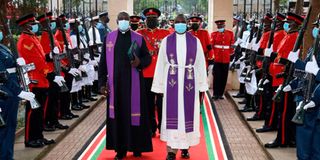
The clergy lead the cortege of the late President Mwai Kibaki at Parliament buildings on April 25, 2022. President Uhuru Kenyatta and First lady Margaret Kenyatta led Kenyans in paying their last respects to the former President.
For Moi, a Bible, a hymnbook and his trademark sceptre were neatly placed on one side of a chair similar to the official chairs used by VIPs during public events. On the other side of the chair was his bust and some military boots, the kind he wore during his time as the commander-in-chief.
Yesterday, the whole foyer was sealed off using end-to-end curtains bearing the colours of the national flag, making it hard to see what was happening.
The body, in an obviously expensive navy blue pin-striped suit, light blue shirt, a white dotted royal blue tie and black moccasin shoes, was guarded by four soldiers drawn from the three formations of the Kenya Defence Forces (KDF) – Kenya Army, Kenya Air Force and Kenya Navy – dressed in ceremonial tunics.
Two of the soldiers were drawn from the Kenya Army, with one each from Kenya Navy and the Air Force.
The four officers stood at each corner of the area where the body lay on a bier with heads bowed, weapons inverted and their backs to the body.
Whereas, two national flags were placed diagonally against Mr Moi’s body, the situation was different yesterday.
At the bottom left of Kibaki’s bier, the KDF flag was neatly folded on a pennant, while at the right bottom was his white coloured presidential standard.
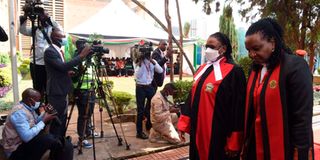
Chief Justice and President of the Supreme Court Justice Martha Koome (left) with Chief Registrar of the Judiciary Anne Amadi arrive for the viewing of the body of former President Mwai Kibaki.
On the opposite end, above the head, a folded national flag was neatly placed on the left side.
The body lay on a white cushioned bier, with the head raised on a white-fringed cloth, symbolising Kibaki’s presidential standard.
On the edge of the wall there was a glass casing that contained the red ceremonial outfit of the Kenya Army, complete with a sword and cap. The uniform was a gift from KDF for the time he served as commander-in-chief and the Chief of the Order of the Golden Heart of Kenya, the highest award in Kenya, mostly given to the holders of the office of the President.
Even though he was a commander-in-chief, Mr Kibaki avoided the fancy traditions and practices of the military.
Not once in his 10 years at the helm did he put on the tunic that is traditionally associated with trooping of colours, an event that involves a recognition of a new regiment or unit of KDF.
By not putting on the tunic, Kibaki broke a strong tradition that had been established by his two predecessors, and perfected by his successor, which includes appointing military officers to execute civilian roles, like managing public corporations.
Yet, it was under Kibaki’s watch as commander-in-chief that Kenya went to war in Somalia.
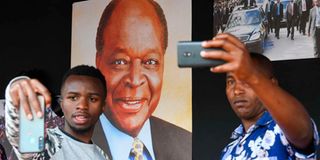
Mourners take photographs next to images of former President Mwai Kibaki at Parliament buildings on April 25, 2022. President Kibaki, who died aged 90, served as the country’s third president, taking over from the authoritarian rule of President Daniel Moi. President Kibaki, whose political career dated back to the birth of independent Kenya, will be buried on April 30 at his home in Othaya in Nyeri.
On October 14, 2011, he authorised KDF tanks to roll into Somalia to fight the Al-Shabaab who had become a menace to the Kenyan economy through abduction of tourists within the coastal belt.
Code-named Operation Linda Nchi, the move into Somalia was a mission to protect Kenya’s territorial integrity. KDF were to secure the border with Somalia, after the killing and abduction of Western tourists, aid workers, and Kenyans had made news.
Alongside the glass casing was a cupboard with a selection of Kibaki’s personal library.
On the top deck was Becoming an African University: Makerere, 1922-2000. Authored by Prof Carol Sicherman, the book provides the most comprehensive history of Makerere University since its inception. In the book, Sicherman notes that Makerere does more than educate young people: it has been, and is, at the centre of changing visions of how to build East Africa’s future.
There is also a white cover note book, with the national emblem.
During his presidency, Kibaki was often seen taking notes in public forums, especially where leaders were raising issues of concern to the people.
Beside the note book is an executive pen, the kind he used.
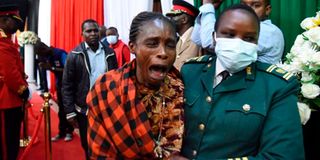
A woman is overcome with grief after viewing the body of President Kibaki at Parliament buildings on April 25, 2022.
The lower deck contains several books written by prominent Kenyan authors, including the Fifth Columnist authored by journalist Philip Ochieng, who died just a year ago.
David Goldsworthy’s Tom Mboya: The Man Kenya Wanted to Forget and former Cabinet Minister GG Kariuki’s Illusion of Power.
Kariuki died in June 2017.
A golf club was placed on the cupboard to symbolise the sport that Kibaki was most associated with. Other than playing the game, he supported golfing activities and sponsored a number of tournaments.
Ms Linah Too, a civil servant, who joined hundreds of Kenyans who thronged Parliament buildings for the public viewing, told the Nation that she had come to pay her last respects to a man who had put smiles on the faces of public servants.
“He improved the terms and conditions of civil servants when he took over,” said Ms Too after viewing the body.
“He put a smile on our faces and I was touched by his death and decided to join Kenyans in mourning his death.”



